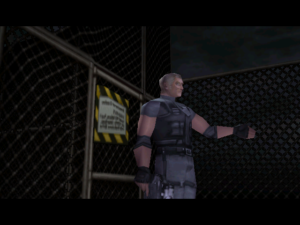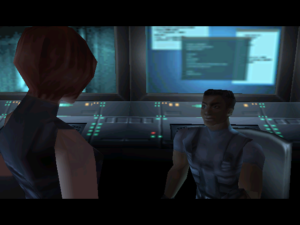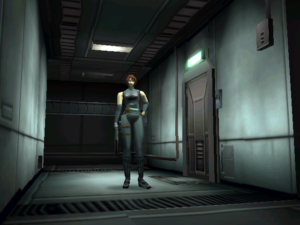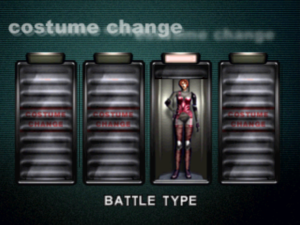Dino Crisis: Technology
At heart, Dino Crisis is mainly a game about technology. It’s a theme that’s present throughout the game, but it really comes to the fore towards the end, when your main goal is to get Dr. Kirk’s room-filling machines working again.
Kirk was researching what he calls “the third energy”. What are the first two energies? No idea. As far as I can tell, “third” is just a way to suggest that things are coming to some kind of dramatic peak, as in Tolkien’s “third age” or Evangelion’s “third impact”. Regardless, the third energy apparently involves harnessing space itself as an enery source. The rifts in time resulting from this, and the dinosaurs that wandered through them, were an unexpected side-effect. And there, we part company from both of the game’s primary inspirations, Resident Evil and Jurassic Park. Like Dino Crisis, both of these works are about man tinkering with nature and suffering unintended consequences, but at least the consequences are directly related to the tinkering. The Umbrella Corporation didn’t actually want a zombie apocalypse, but they did deliberately expose humans to the T-virus with the aim of producing monsters. Hammond didn’t want the dinosaurs to escape and start eating people, but he was aware of the possibility and considered it an acceptable risk when he set up the park. In both cases, their mistake was thinking that they could control their creations. Kirk? He wasn’t trying to control dinosaurs. He had no idea there would be dinosaurs to control. The dinosaurs are almost tangential to the plot. You could swap them out with any other random monster and the story would make just as much sense. Heck, all you have to do is replace “millions of years ago” with “an alternate universe” and you’ve got the premise of Half-Life.
The goals in the game are all about technology: find various disks and keycards that give you access to further reaches of the complex, turn on power systems, access computers, etc. And they’re not so much about defeating technology as about mastering it. There are a lot of Laytonesque self-contained mini-puzzles — I think the most engaging one I’ve seen involves rotating and stacking three pieces of a grille to produce a specific pattern. These are the riddles that the machines pose to you to prove your worthiness to use them. Once you’ve answered them, they will do your bidding. Even those locked doors become your allies against pursuing dinosaurs. The dinosaurs themselves cannot be mastered in this way. They’re only worthy of slaughter.
 Comments(2)
Comments(2)


